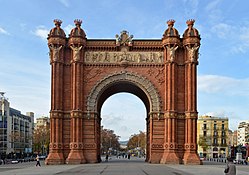Arc de Triomf
| Arc de Triomf | |
|---|---|
 | |
 | |
| General information | |
| Type | Memorial arch |
| Architectural style | Neo-Mudéjar |
| Location | Passeig de Lluís Companys, Barcelona, Spain |
| Inaugurated | 20 May 1888 |
| Height | 29.8 metres (98 ft) |
| Dimensions | |
| Other dimensions | Wide: 27.7 metres (91 ft) Deep: 12.4 metres (41 ft) |
| Technical details | |
| Material | Brickwork |
| Design and construction | |
| Architect(s) | Josep Vilaseca |
| Other information | |
| Public transit access |
|
The Arc de Triomf (Catalan pronunciation: [ˈaɾk də tɾiˈomf]) is a memorial arch in Barcelona, Catalonia, Spain. It was built by architect Josep Vilaseca i Casanovas as the main access gate for the 1888 Barcelona World Fair. The arch crosses over the wide central promenade of the Passeig de Lluís Companys, leading to the Ciutadella Park that now occupies the site of the world fair. It is located at the northern end of the promenade, facing the Passeig de Sant Joan.
Design
The arch is built in reddish brickwork in the Neo-Mudéjar style. The front frieze contains the stone sculpture Barcelona rep les nacions (Catalan for "Barcelona welcomes the nations") by Josep Reynés. The opposite frieze contains a stone carving entitled Recompensa ("Recompense"), a work from Josep Llimona's earliest period, representing the granting of awards to the participants in the World Exposition. The friezes along the sides of the arch include allegories of agriculture, industry and trade by Antoni Vilanova and of sciences and arts by Torquat Tassó. The two pillars of the arch feature bats carved in stone, which were the emblem of King Jaume I, who ruled over a period of prosperity in Barcelona. The voussoirs of the arch are made of stone sculpted like a large laurel wreath that supports the coats of arms of the forty-nine provinces that formed the Kingdom of Spain in 1888. The keystone of both arches presents the coat of arms of the city of Barcelona, above the rest of the shields and in larger dimensions.[1][2]
-
Barcelona welcomes the nations, Josep Reynés.
-
Recompense, Josep Llimona.
-
Apotheosis of agriculture, industry and trade. Antoni Vilanova.
-
Apotheosis of sciences and arts. Torquat Tassó.
Other triumphal arches
Similar structures can be found in many other cities, most notably including the Arc de Triomphe in Paris, the Wellington Arch in London, the Soldiers' and Sailors' Arch in New York City, and the Arcul de Triumf in Bucharest, plus many from the Roman era. This arch, however, is a non-military arch. It does not romanticize war, not intended to celebrate Spain's military victories, but rather was built as the gateway to the 1888 World Fair and was thus intended to welcome people.
References
- ^ "Arc de Triomf and Passeig de Picasso". barcelona.de. Retrieved 26 August 2017.
- ^ "Brief description and history of Barcelona's Arc de Triomf". Barcelona Tourism.




